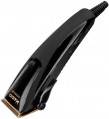Power
The performance of the tool, the maximum rotation speed of the motor and how well the device handles with thick and coarse hair depends on the power of the electric motor. So, for cutting thick head hair, you need a clipper with a power of at least 15 W, the performance of such a device is usually enough to ensure a motor rotation speed of 10,000 rpm. But there are also more
powerful clippers(from 20 W). Trimmers for beards and mustaches usually need 5 W of power. Such models most often have a performance of 3,000 – 5,000 rpm.
Blades material/coating
—
Stainless steel. The standout feature of stainless steel is its exceptional resistance to rusting. When the clipper or trimmer boasts a sealed casing, the stainless steel cutting head can be conveniently cleaned using water pressure. While stainless steel is common in lower-tier devices and its blades can endure high temperatures, they tend to lose sharpness relatively swiftly.
—
Titanium. Titanium alloys showcase impressive durability against substantial mechanical strain. The titanium cutting edge adeptly manages hair of various thicknesses and densities, retaining its sharpness admirably. Tools equipped with a titanium blade are reliable for frequent usage, notably in beauty salons. However, the drawback lies in their notably steep expense.
—
Ceramic. Ceramic offers remarkable strength; its blades remain cool and sharp over time. Machines or trimmers featuring ceramic blades effortlessly handle even the thickest hair, allowing for frequent and prolonged use. Interestingly, models with ceramic blades often come at a more affordable price compared to those with titanium blades. Nonetheless, fragility is a significant drawback of ceramics; these blades are susceptible to damage from impacts and falls. Clippers and trimmers that are equipped with a ceramic cutting part must be handled with extreme delicacy.
—
Titanium ceramics.... Blades made of ceramic with a high titanium content. Ceramic in the context of the material used improves cutting performance, reduces friction and maintains a sharpness for a long time, and the titanium coating gives the blades strength, provides resistance to wear and corrosion. Titanium-ceramic blades are good for cutting coarse, thick hair, but they are quite expensive.
— Diamond. Diamond-coated blades have increased edge strength. Typically, these blades are based on steel, most often stainless, but thanks to diamond coating, the knife acquires higher reliability and durability. Of course, the presence of diamond coating on the blade significantly increases the cost of the device.
— Steel. Steel blades are the budget-friendly option. Steel performs effectively in devices used sporadically, mainly for home purposes. Although steel edges tend to lose sharpness relatively swiftly, their durability can be enhanced through the application of protective coatings like diamond, ceramic, or titanium. Clippers or trimmers with uncoated steel blades typically fall into the low-cost category.
— Graphite. Graphite coating is typical for stainless steel blades, it allows the blade to glide more easily through hair and skin and generally increases the efficiency and convenience of working with such a device. Most often, detachable trimmer blades are equipped with graphite coating.Features
—
Self- sharpening blades. Blades made using a special technology, thanks to which they sharpen themselves, due to friction against each other in the process. Thus, the blades remain sharp at all times, and their maintenance is limited to the replacement of worn blades.
—
Function of thinning. Thinning in hairdressing is called cutting the ends of the hair at different levels — as a result, after the haircut, the hairstyle looks more natural and magnificent. In machines, special thinning nozzles are usually used for this.
—
Wet cleaning. The clipper's capacity for wet cleaning of its attachments, allowing them to be rinsed under flowing water, is a notable feature. It's important to clarify that this pertains exclusively to the attachments – not all models with wet cleaning have waterproof casings (see below). Nevertheless, even without a waterproof casing, it might still be feasible to clean the attachments without detaching them from the device. In general, wet cleaning is frequently more efficient, quicker, and precise compared to dry cleaning.
— Waterproof body.In this context, a sealed enclosure is indicated, enabling the machine to withstand water exposure without adverse effects. The extent of protection can vary; certain models tolerate brief water immersion, while others can operate even when submerged. These specifics should be detai
...led in the accompanying instructions. Nevertheless, for clippers used in environments with elevated humidity (like bathrooms or wet areas), having such a water-resistant enclosure is greatly preferred, and sometimes obligatory.
— Built-in vacuum cleaner. The clipper is equipped with a vacuum cleaner, which greatly facilitates cleaning after cutting. The suction hole located under the blades sucks most of the cut hair into a separate reservoir. Of course, there will not be a 100% return, but there will be much less hair scattered on the floor. However, when cutting a beard, a vacuum cleaner will do just fine.
— Laser pointer. The presence in the electric razor of a laser in the form of a straight line. With its help, you can easily, and most importantly, evenly and symmetrically trim the desired areas.Cable length
The length of the cable determines how far the user can move with the device from the outlet. On average, the length of the current-carrying wiring of the clipper / trimmer is about 2 metres. This parameter is relevant only for networked (230 V) and hybrid (network + battery) models.
